|
Monday 20th to
Sunday 26th February 2023 |
| |
|
There are several good early evening
observing opportunities which are great if you don't fancy those late
nights! |
| |
|
Firstly, around 8pm on Monday 20th the open
cluster of stars known as the "Shoe-Buckle" cluster or Messier 35 reaches
its highest position in the sky, when atmospheric disturbance will be the
least. The magnitude +5.0 cluster will be just visible with the naked eye
from a very dark location; binoculars or a telescope will provide a stunning
view. M35 will be located towards the south, above the constellation of
Orion, slightly below and to the left of planet Mars. |
| |
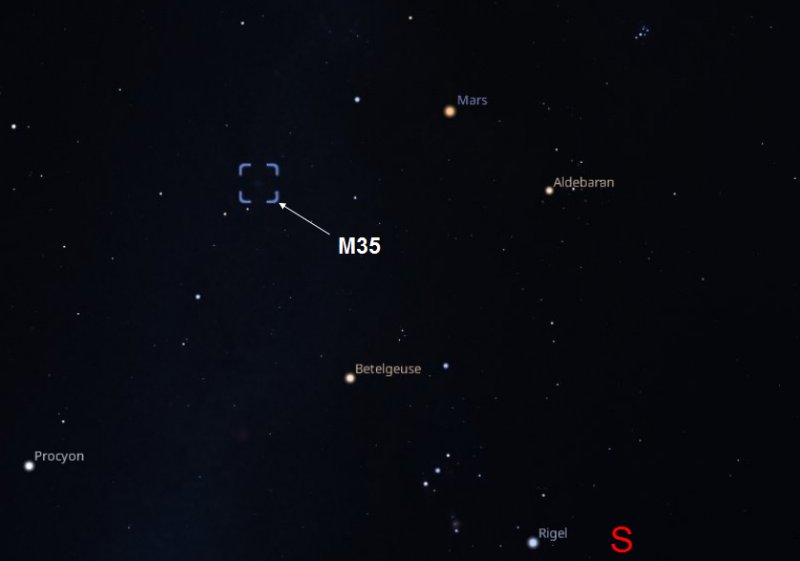 |
| |
|
If you are using a telescope, just down and
to the right of M35 is another open cluster NGC2158. The two clusters are
un-related......M35 is only 3000 light years away, where the much fainter
NGC2158 is more like 9000 light years away and 2 billion years old! |
| |
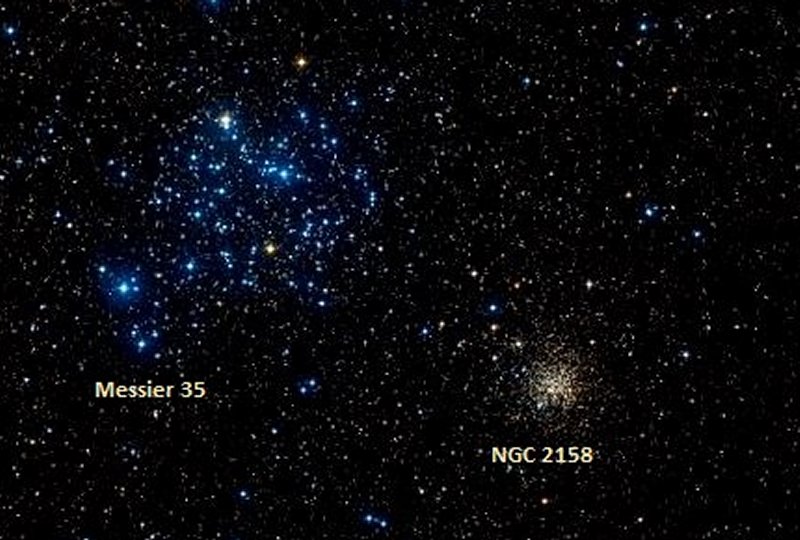 |
| |
|
Image courtesy
of Wikipedia |
| |
|
Just after dark on Wednesday 22nd a thin
8%-lit Crescent Moon forms a line with Venus and Jupiter as the trio set
towards the west horizon. |
| |
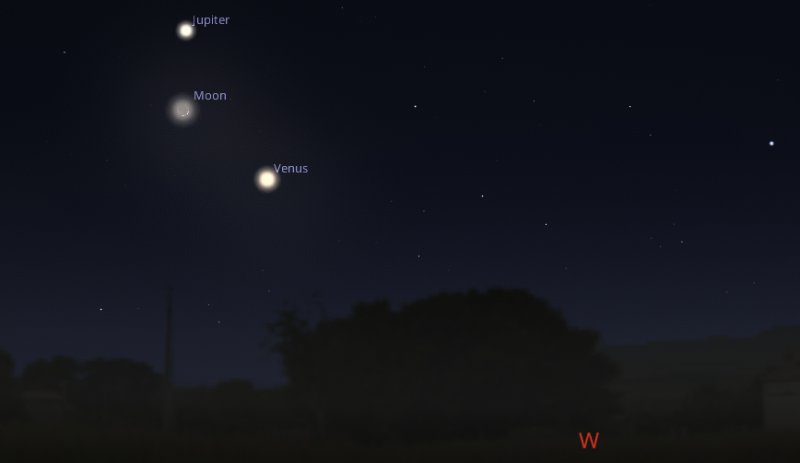 |
| |
|
Venture outside at the same time a few days
later, on Sunday 26th and the Moon will have become a 44%-lit crescent and
it will be located towards the south, very close to the Pleiades open
cluster of stars. |
| |
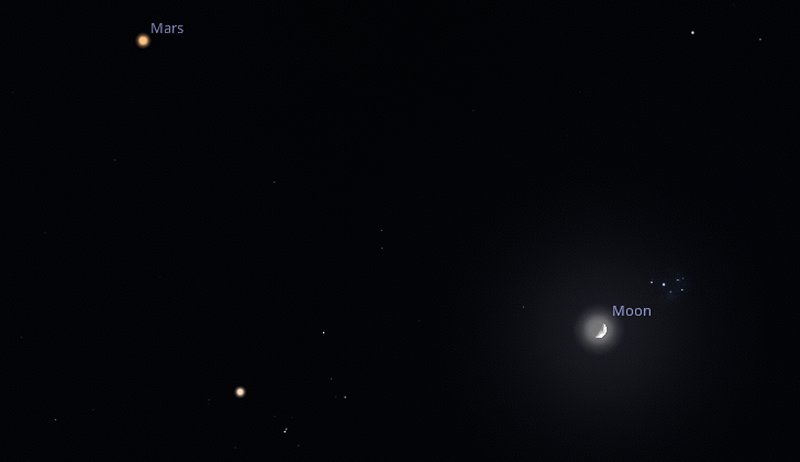 |
| |
|
At 6.12am on the morning of Tuesday 22nd
there is an opportunity to spot the International Space Station. It will
appear in the south west and spend around six minutes passing overhead
before disappearing towards the east. |
|
Monday 13th to
Sunday 19th February 2023 |
| |
|
Comet C/2022 E3 ZTF features in a lot of
astronomy reports. More recently it has been visible to the naked
eye.......in theory at least! Observers have had mixed success spotting it
as, not only is the comet quite difficult to locate in the night sky, but
the amount of light pollution in your area and atmospheric disturbance can
make viewing a challenge. |
| |
|
Your best bet will be on the evening of
Tuesday 14th when the comet will be slightly to the left of the bright star
Aldebaran in the constellation of Taurus. It should have a magnitude of
around +6.0 so I would dig out those binoculars or telescope for a greater
chance of success. |
| |
|
If you venture outside after your Valentine's
Day dinner, around 10pm, Aldebaran will be towards the west, halfway between
the constellation of Orion and the Pleiades open cluster of stars, a little
below planet Mars. |
| |
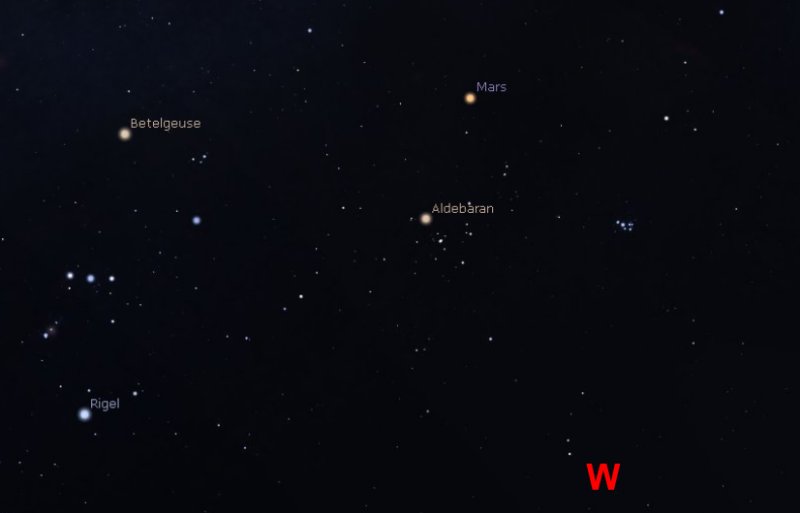 |
| |
|
For early risers, a Crescent Moon appears
above the south east horizon a little before 6am on Thursday 16th. The
Moon's "libration" or "wobble" means that the western limb of its surface is
tilted slightly towards us which is an ideal time to spot some of the
features right on the western edge like the Mare Orientale. |
| |
|
Friday 17th is the date for the last of my
astronomy evenings at the Ham Hill Visitor Centre, starting with a talk
about the night sky at 7pm, followed by a star party if the weather is
favourable. |
|
Monday 6th to
Sunday 12th February 2023 |
| |
|
Through January, I made several mentions of
comet C/2022 E3 ZTF and it can still be seen at the beginning of February.
The comet will have a magnitude of around +6.0 so you will need binoculars
or a small telescope. |
| |
|
It can be quite challenging to locate the
comet, but if you venture outside around 1am on Saturday 11th and find
planet Mars in the west, the comet will be a little above and to the left of
the planet. If you venture outside the following night, at 1am on Sunday
12th, the comet will then appear a little below and to the left of Mars. |
| |
|
Do you remember the ill-fated Apollo 13
mission that was unable to land in the Fra Mauro Highlands on the Moon
because their Oxygen tank exploded en route? Later, Apollo 14 landed there
instead and the rock samples they took indicated that the area was hit by a
meteorite over 4.5 billion years ago. |
| |
|
Well the early hours of Sunday 12th is an
ideal opportunity for you to take a look at the crater Fra Mauro and the
surrounding highlands yourself. After you have finished trying to see the
comet, turn your gaze towards the south east, where by 1am a Quarter Moon
will have risen above the horizon. |
| |
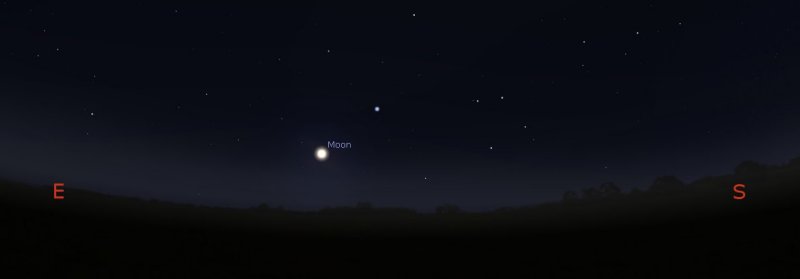 |
| |
|
If you imagine the surface of the Moon as a
clock face, the Fra Mauro region is towards what would be the 7 o'clock
position, a little down and left of centre. |
| |
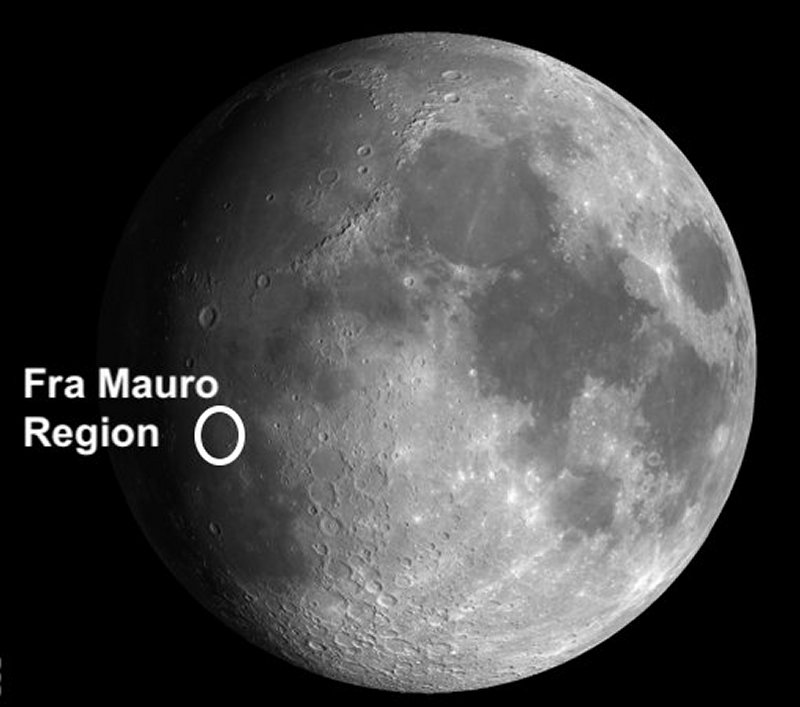 |
| |
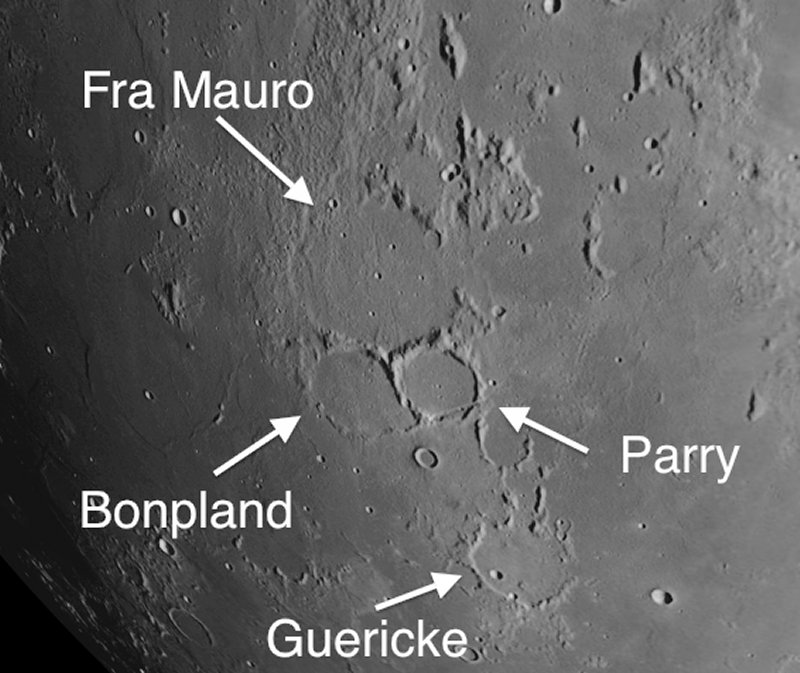 |
| |
|
Fra Mauro images courtesy of astronomer Andrew Planck |
|
Monday 30th
January to Sunday 5th February 2023 |
| |
|
If you stay up late past midnight, into the
early hours of Monday morning 30th, there are several things to see looking
towards the west. At 1am a 64%-lit Gibbous Moon will be about to set below
the horizon and a little above it will be the Pleiades open cluster of
stars. |
| |
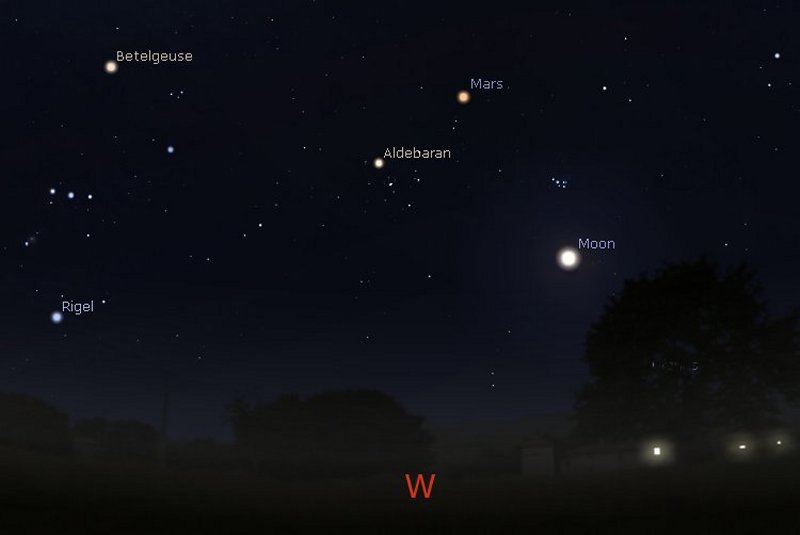 |
| |
|
Above and a little to the left of the
Pleiades you will find planet Mars shining quite brightly at a magnitude of
around -0.3 and to the left of Mars, the bright star Aldebaran in the
constellation of Taurus. Further left again is the constellation of Orion
with its red giant star Betelgeuse at the top and the much younger and
hotter star Rigel towards the bottom. |
| |
|
Draw an imaginary line to the left of Orion's
belt and you will come across the brightest star in the night sky - Sirius. |
| |
|
If late night observing isn't your thing and
you prefer an early start, at daybreak on Monday 30th, planet Mercury will
be at its greatest western elongation or in other words, it's furthest
separation (about 25 degrees) from the rising Sun. If you go outside just
before 7am, Mercury will be rising above the horizon towards the south east. |
| |
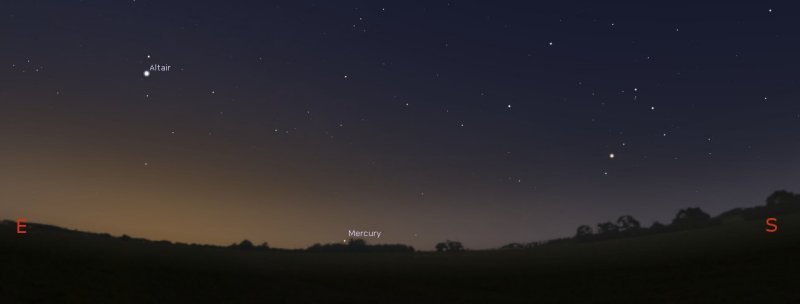 |
| |
|
The planet will easily be visible to the
naked eye, so please don't be tempted to use binoculars or a telescope to
obtain a better view - the Sun will be appearing very shortly afterwards and
you must never risk catching even a split-second glimpse of the Sun through
any optical instrument. |
|
Monday 23rd to
Sunday 29th January 2023 |
| |
|
Just after sunset on Monday 23rd, there is an
opportunity to see Venus and Saturn close together, just before they set
below the horizon. They will be joined by a very thin 5%-lit Crescent Moon
to the left of them. Around 6pm, the trio will be located towards the south
west. |
| |
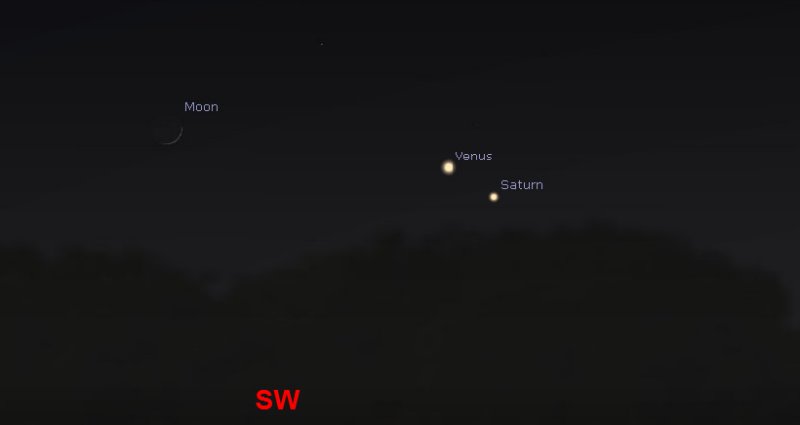 |
| |
|
Two days later, on the evening of Wednesday
25th, the Moon will be close to Jupiter if you look south west, again around
6pm. By then the Crescent Moon will be 21%-lit. |
| |
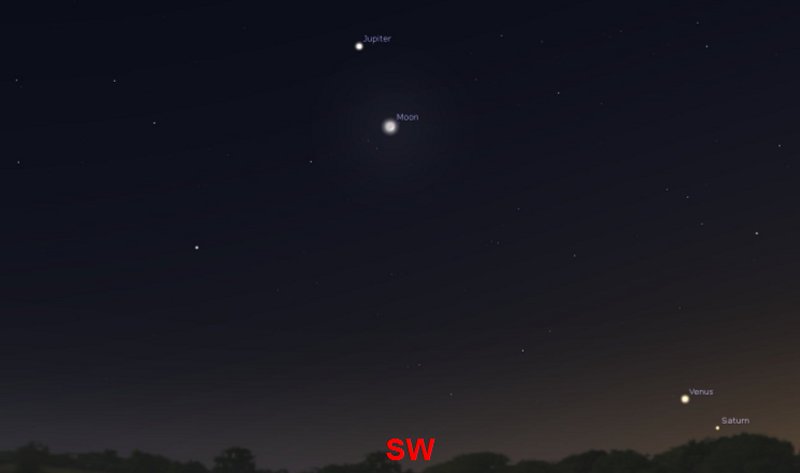 |
| |
|
Comet C/2022 E3 ZTF will be getting brighter
throughout this coming week. On Friday 27th it will appear close to the
star Kochab in the constellation of Ursa Minor and by Sunday 29th it will be
nearer Polaris, the Pole Star, with its brightness increasing to around
+4.9 |
| |
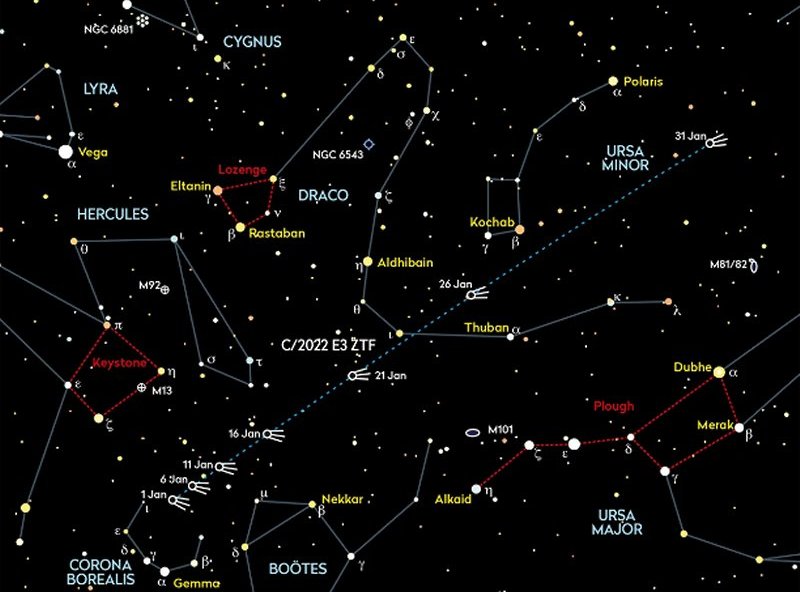 |
| |
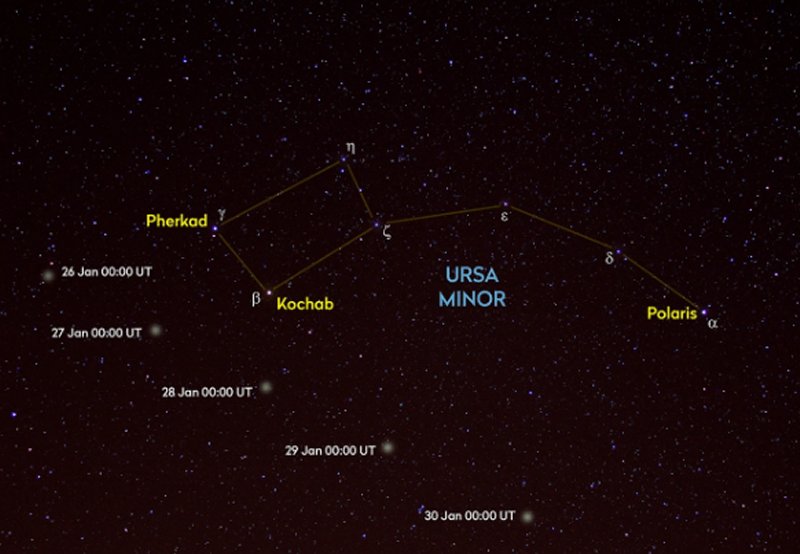 |
| |
|
Comet diagrams courtesy of Pete Lawrence and Sky At
Night Magazine |
| |
|
I am delivering one of my astronomy lectures
at the Ham Hill Visitor Centre on the Friday evening and if skies are clear,
we will be venturing outside afterwards for a little star party. In
addition to observing usual favourites like the Andromeda Galaxy, Pleiades
open cluster of stars and the Great Orion Nebula, we will have a go at
hunting down the comet ourselves. |
| |
|
If you would like to attend the event,
booking is through the visitsouthsomerset.com website: |
| |
|
www.visitsouthsomerset.com |
| |
|
I will be holding another event at the Centre
on Friday 17th February, although by then the comet will be out of view so
we will go exploring other targets that evening. |
|
Monday 16th to
Sunday 22nd January 2023 |
| |
|
Last week I mentioned the Moon's "libration"
or wobble as it orbits around the Earth every 27 days. It means that at
certain times, different bits of the surface are tilted a little more
towards us. |
| |
|
On Wednesday 18th, the western edge of the
Moon is slightly more visible and this is a great chance to spot the Mare
Orientale. Mare are large dark basaltic plains and early astronomers
thought that they were actually seas, hence the Latin name for them. Mare
Orientale resembles a large "bullseye" and it is normally hard to see as
it's on the edge between the nearside and darkside of the Moon. |
| |
|
If you're an early riser, at around 6am on
18th, a Crescent Moon will be close to the horizon towards the south east.
I have provided a diagram below to help you locate the Mare together with a
photograph of it that was taken by NASA's Lunar Orbiter 4 probe back in
1967. |
| |
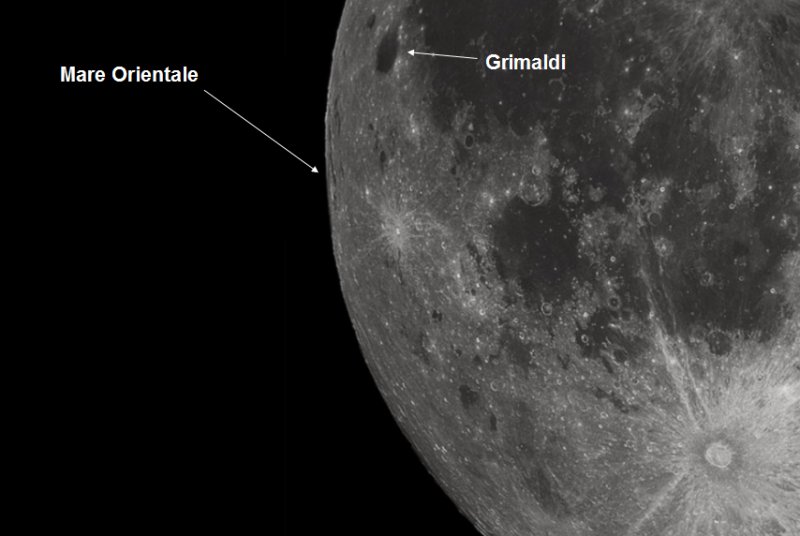 |
| |
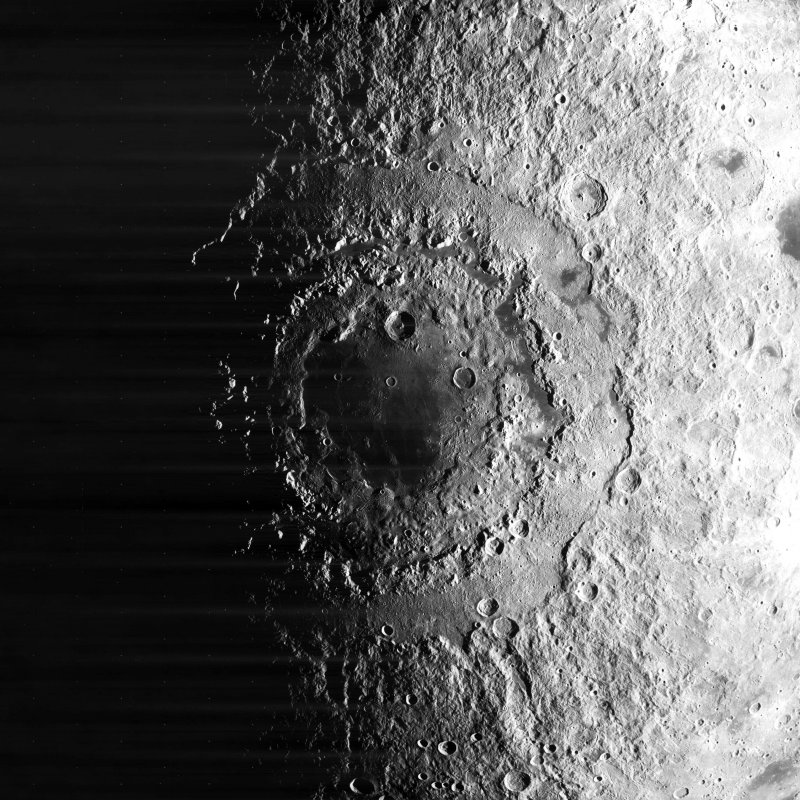 |
| |
|
If early mornings are not your thing, then
you could go outside at 6pm on Sunday 22nd and look towards the south west
horizon. Venus and Saturn will appear to be very close together just before
they set. Venus will be the lower of the two pinpoints of light. |
| |
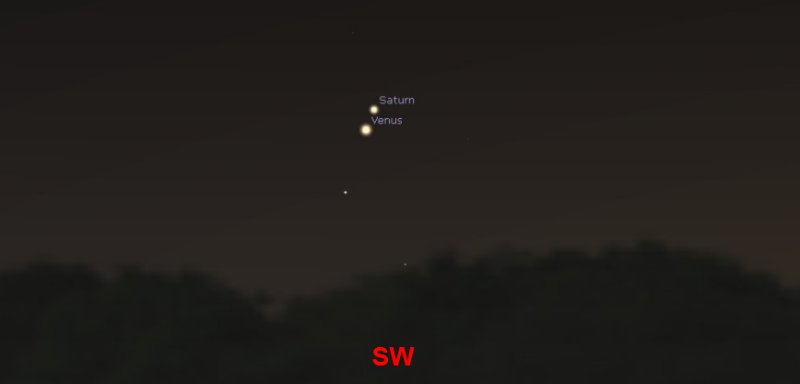 |
| |
|
If you're tempted to use your telescope or
binoculars for a better view, please remember not to aim in that direction
until the Sun has completely disappeared below the horizon as you must never
risk accidentally catching even a brief glimpse of the Sun through them! |
|
Monday 9th to
Sunday 15th January 2023 |
| |
|
On Monday 9th, we will have just gone past a
Full Moon and the Moon's "libration" or slight wobble as it orbits around
the Earth means that its southern polar region will be tilted slightly
towards us - an ideal opportunity to hunt for some of the many craters on
that part of its surface with your telescope. If you venture outside around
9pm on 9th, the Moon will have risen above the horizon to the east. |
| |
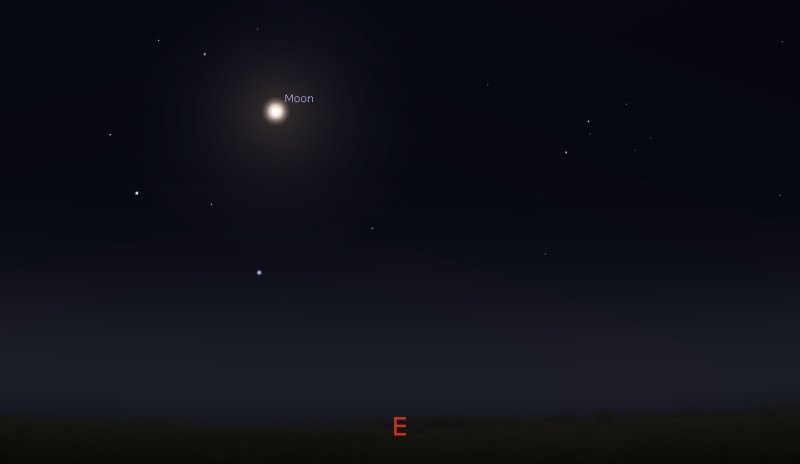 |
| |
|
The last month has been a great time to
observe Mars while it has been at its brightest and closest to the Earth.
Things are changing now and although the coming week is still good to go
looking for those elusive Martians, by Sunday 15th the planet will have
dimmed to a magnitude of around -0.7 and will look slightly smaller in your
eyepiece. |
| |
|
Curiously, on Thursday 12th, Mars reaches a
stationary point in the sky. What on Earth does that mean! Planets don't
stop moving! Up until the 12th, its motion has been "retrograde" meaning
that each night its position has been shifting west against the background
of stars. From Thursday, its motion will be "prograde", or in other words,
moving east which is what you would normally expect. At 9pm on 12th, Mars
will be located towards the south, between the constellation of Orion and
the Pleiades open cluster of stars, a little above the bright star
Aldebaran. |
| |
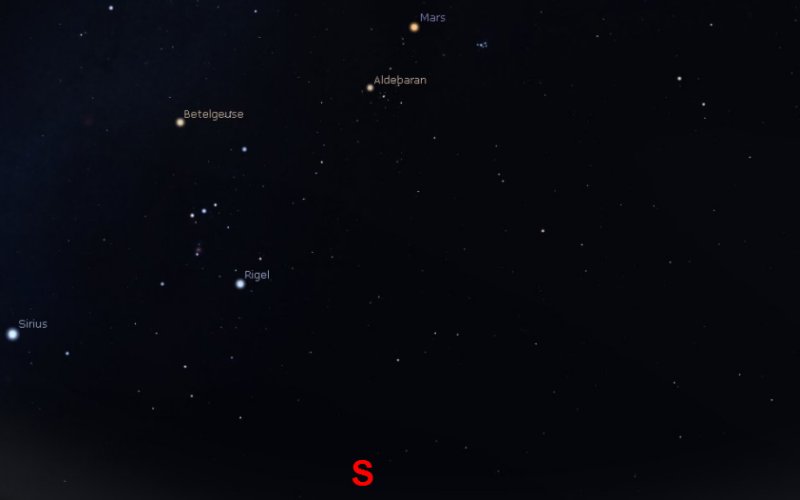 |
| |
|
Remember that anytime this month is a good
opportunity to spot comet C/2022 E3 ZTF that was only first-discovered last
year. By Sunday 15th, the comet will have increased its magnitude to about
+6.3 so it will almost be visible to the naked eye. |
| |
 |
| |
 |
| |
|
Comet diagrams courtesy of Pete Lawrence and Sky At
Night Magazine |
|
Monday 2nd to
Sunday 8th January 2023 |
| |
|
I suggested trying to find comet C/2022 E3
ZTF with your telescope or binoculars on Christmas morning, when it would be
located within the constellation of Corona Borealis. It will actually be
possible to see the comet throughout the whole of January and as the days go
by, it will appear to move from the edge of Corona Borealis towards Ursa
Minor and progressively become brighter. |
| |
|
The optimum viewing will be during the night
of 27th / 28th January, when the comet will be fairly close to the star
Kochab in Ursa Minor and its magnitude will be around +4.8, so potentially
even visible with the naked eye from a dark sky location. As a bonus that
night, the Moon sets a little after midnight so there will be no light
pollution from that source. |
| |
|
I have provided diagrams below showing the
comet's position through the month, courtesy of Pete Lawrence and Sky At
Night Magazine: |
| |
 |
| |
 |
| |
|
The evening of 27th January is also the date
for the first of this year's talks and star parties I am holding at the Ham
Hill Visitor Centre, so assuming the skies are clear and we can venture
outside, after we have looked at the usual favourite targets of the
Andromeda Galaxy, Pleiades open cluster and Great Orion Nebula, then we
might be able to go comet-hunting! |
| |
|
The second of those talks will be on February
17th and places for either of the events can be booked through the
visitsouthsomerset.com website: |
| |
|
www.visitsouthsomerset.com |
|
Monday 26th December 2022
to Sunday 1st January 2023 |
| |
|
I gather that Santa Claus has been
exceptionally busy this year delivering all the Christmas presents; so busy
in fact that he is going to be very late getting home to the North Pole! |
| |
|
If you go outside early on Boxing Day morning
and look towards the west at 6.23am you should be able to see his sleigh
shooting across the sky as he heads home. He will take about 5 minutes to
pass overhead, before disappearing to the east. The sleigh will look like a
star that is moving. |
| |
|
I've mentioned the Clair-Obscur visual
effects that occur on the lunar surface before and the evening of Friday
30th is the optimum time to spot the "Lunar X and V". Best to aim for
around 9pm, when the Moon will be located towards the south west with
Jupiter a little below it and to the right. |
| |
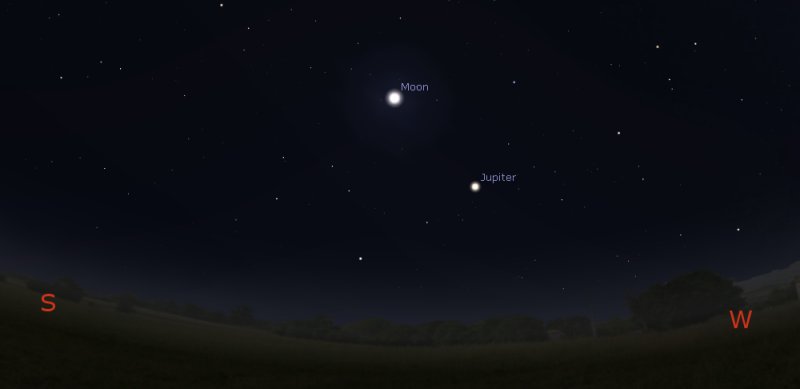 |
| |
|
The first NASA Artemis un-manned mission
returned safely from lunar orbit last week and while you are pointing your
telescope at the Moon, to the right of the Lunar X and V is the Sea of
Tranquility where Apollo 11 landed back in 1969. The descent stage of the
lunar lander and the astronauts' footprints are still there, but they are
way too small to be seen from Earth even with the most powerful telescope. |
| |
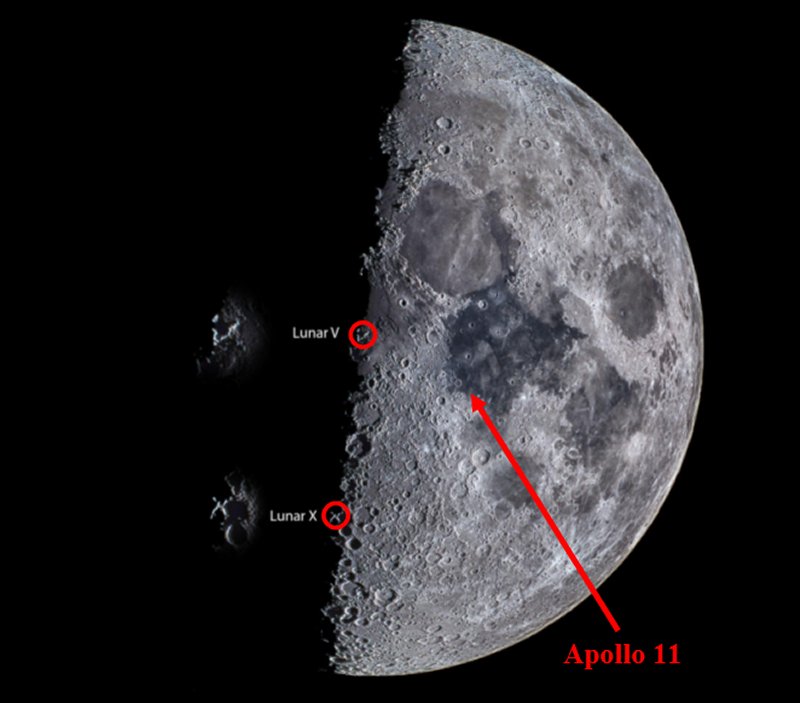 |
| |
|
If Father Christmas brought you a new
telescope this year and you want to learn how to use it, I am holding
another couple of talks at Ham Hill on Friday 27th January and Friday 17th
February. Booking is through the
www.visitsouthsomerset.com website and the last events sold out
very quickly, so I'd advise getting online as soon as possible to guarantee
a place. |
|
Monday 19th
to Sunday 25th December 2022 |
| |
|
Wednesday 21st is the winter solstice, when
the northern hemisphere is tilted furthest away from the Sun and we have the
shortest day - great for astronomers who prefer the longer nights. |
| |
|
The evening of Wednesday 21st is also the
best opportunity to observe planet Mercury just above the south west horizon
shortly after sunset. The planet will have a magnitude of -0.4 so will be
easy to spot with the naked eye - no need to risk using a telescope or
binoculars. Mercury will appear to be at its greatest elongation or
distance away from the Sun. |
| |
|
The evening of Thursday 22nd sees the peak of
another meteor shower. This time it's the Ursids, that appear to radiate
from near the star Kochab in the constellation of Ursa Minor. Any shooting
stars you see are debris left by comet Tuttle. Polaris, the pole star, is
located at the end of Ursa Minor, so you will be looking due north. |
| |
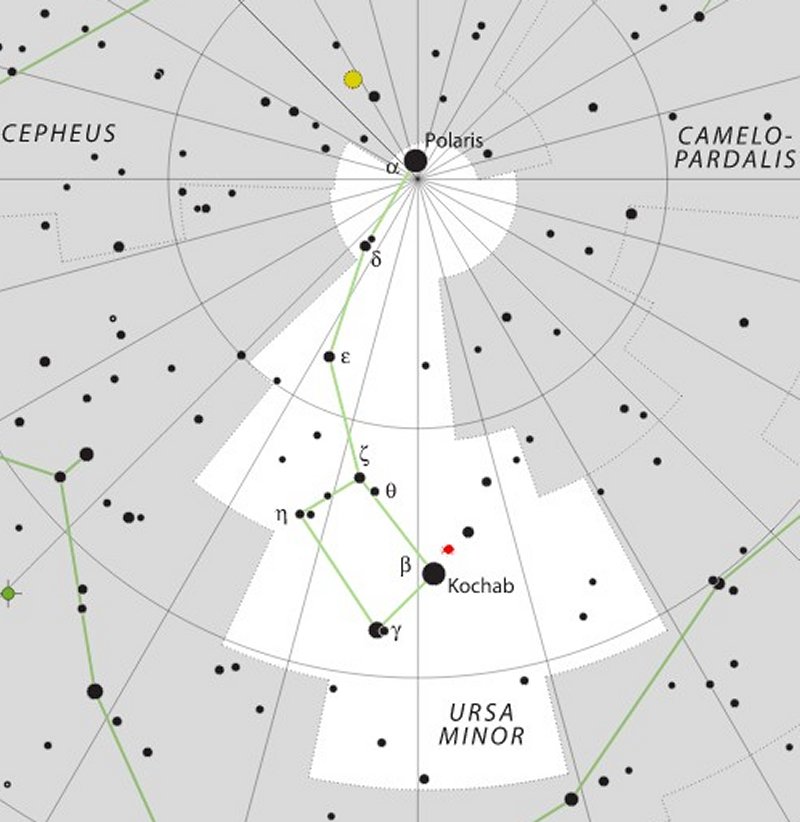 |
| |
|
Talking of comets, there is a treat for
binocular or telescope users on Christmas Day if you're up early, before you
tackle that turkey! Comet C/2022 E3 ZTF will have a magnitude of around +8
and will be located inside the constellation of Corona Borealis. At 6am,
the constellation will be towards the east. Find Ursa Minor and the pole
star, then go right until you see the constellation of Bootes, quite high
up, with the bright star Arcturus. Corona Borealis is situated a little
below Bootes. |
| |
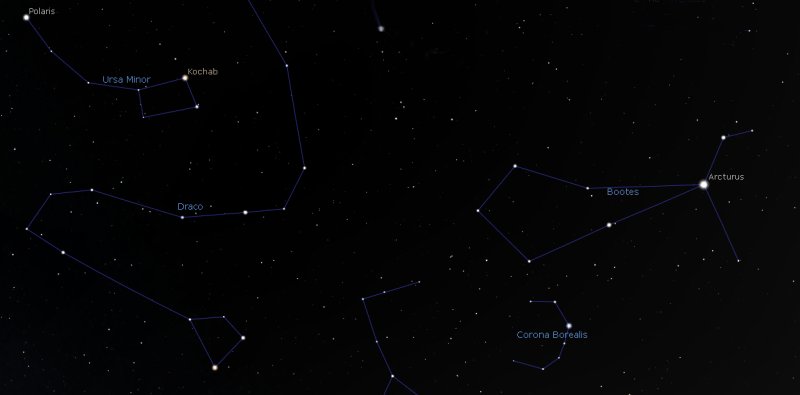 |
| |
|
The comet was first discovered only earlier
this year, by the Zwicky Transient Facility at Palomar Observatory, hence
the "ZTF" in the name. |
| |
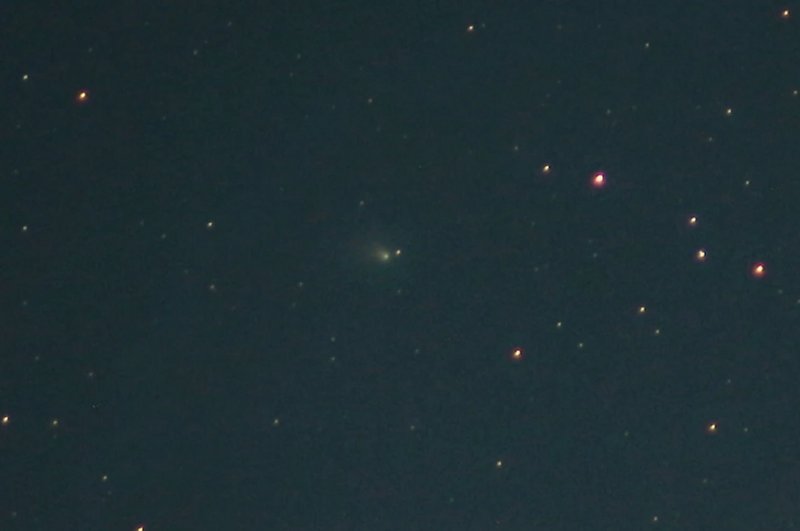 |
| |
|
Image courtesy of Stuart Atkinson /
Sky At Night Magazine |
| |
|
At 7.08am on Christmas morning, I am reliably
informed that Santa Claus will be passing over the UK in his sleigh. He
will look like a star that is moving, initially appearing in the west and
then disappearing towards the east seven minutes later because he is going
so fast! |
| |
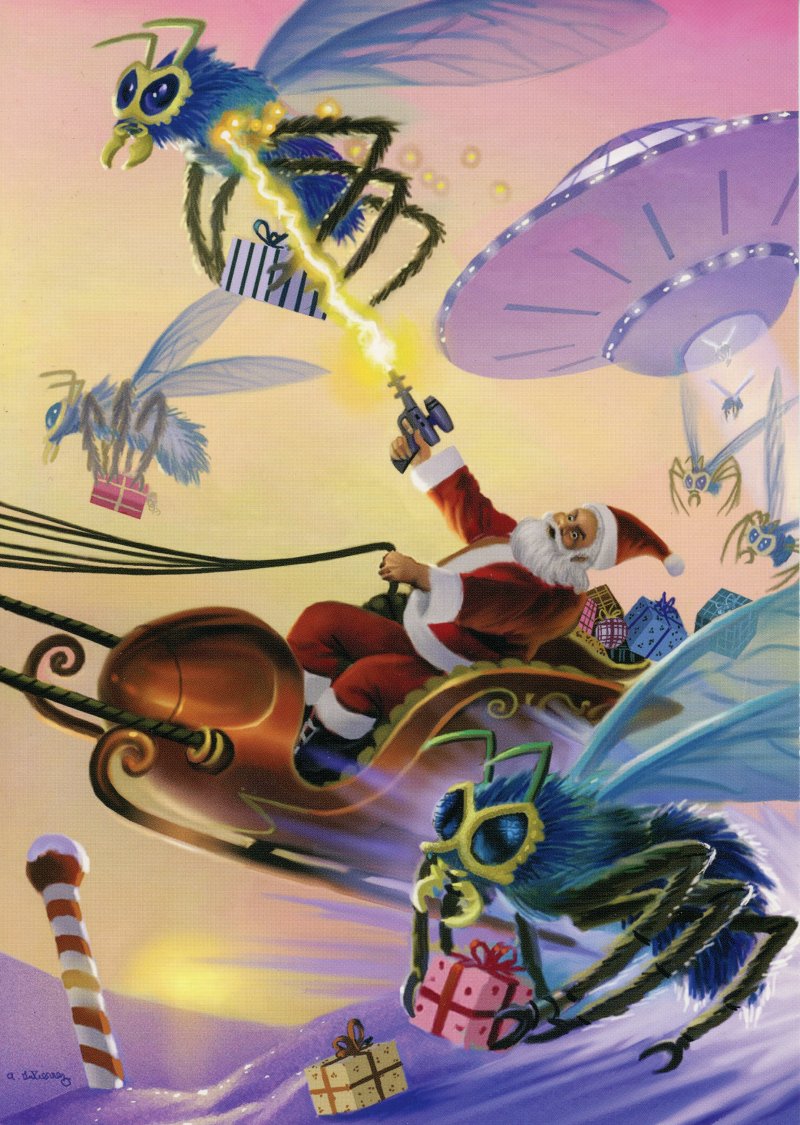 |
| |
|
Very Merry Christmas everyone! |
|
Monday 12th
to Sunday 18th December 2022 |
| |
|
The night of Tuesday 13th / Wednesday 14th is
close to the peak of the Geminids meteor shower, so named because the
radiant point where the shooting stars appear to originate from is close to
the constellation of Gemini "The Twins". |
| |
|
The actual peak of the shower is at 1pm on
13th, but of course you won't see anything then because it will be
daylight! If you are outside just before midnight on 13th, the
constellation will be located towards the south east. Unfortunately a very
bright waning Gibbous Moon will be to the east, creating some light
pollution and spoiling your view of any meteors a bit. |
| |
|
Maybe the Moon can make up for this by
revealing one of its unusual features the following evening, on Thursday
15th. Known as the "Straight Wall", it is a linear fault or escarpment on
the Lunar surface. Don't be misled, as Sir Patrick Moore once said, "it is
neither straight, nor a wall". It is quite distinctive though. |
| |
|
The Straight Wall is best viewed 1 or 2 days
after a First Quarter Moon or a couple of days before the Third Quarter, so
the late evening of Thursday 15th is ideal. The Moon will be located
towards the east and I have provided a diagram below to show how find the
feature courtesy of Jodrell Bank. |
| |
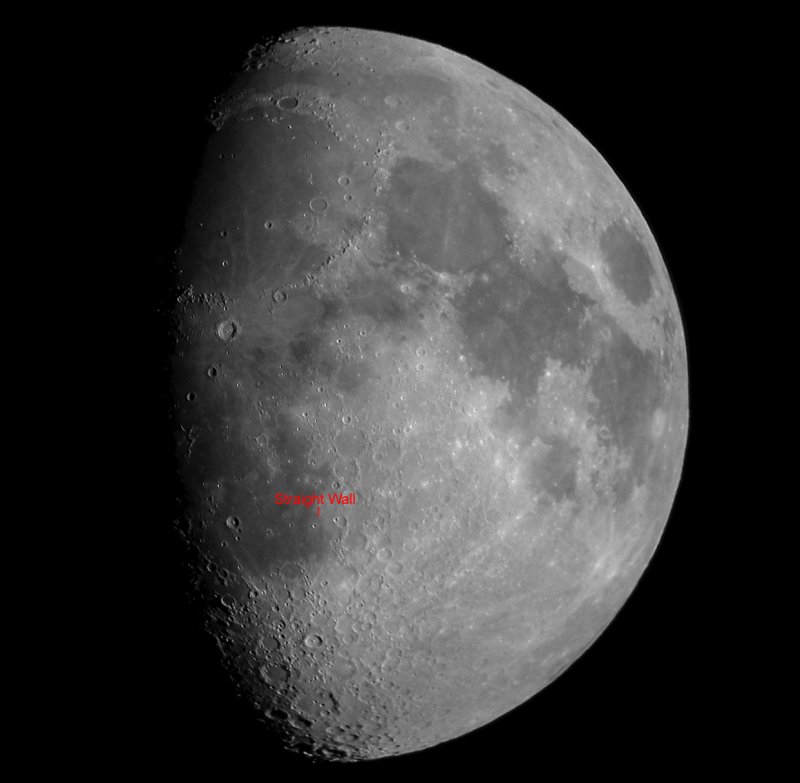 |
| |
|
If you aim your telescope in that direction,
you will be looking at a fault line that is only 110Km long and between 2 -
3Km wide. It looks like a steep cliff because the sunlight falling on it
casts a shadow. In reality it is not very steep at all - it's a trick of
the light! |
| |
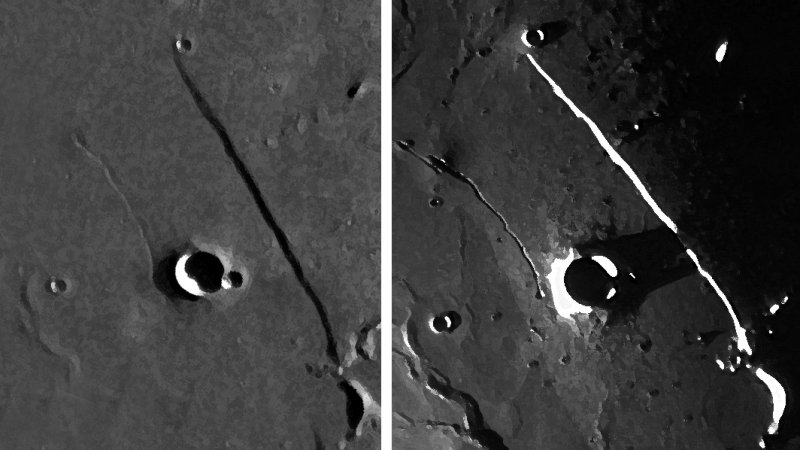 |
|
Monday 5th
to Sunday 11th December 2022 |
| |
|
It's a period of occultations! Sounds like a
series of sinister black magic ceremonies are going to be taking place, so
I'd better explain.......... |
| |
|
In astronomical terms, an "occultation"
occurs when one celestial body appears to pass in front of another,
temporarily blocking it from our view. Next week, the Moon is the culprit,
with Uranus and then Mars being the victims. |
| |
|
Firstly, between 4.50pm and 5.20pm on Monday
5th, the Moon (that will be located towards the east) will occult Uranus.
It will take about 20 seconds for the Moon's north west edge or "limb" to
cover the planet and the same time for it to reappear behind the Moon's
north east limb half an hour later. In other words, the northern area of
the Moon's surface will appear to hide the planet. |
| |
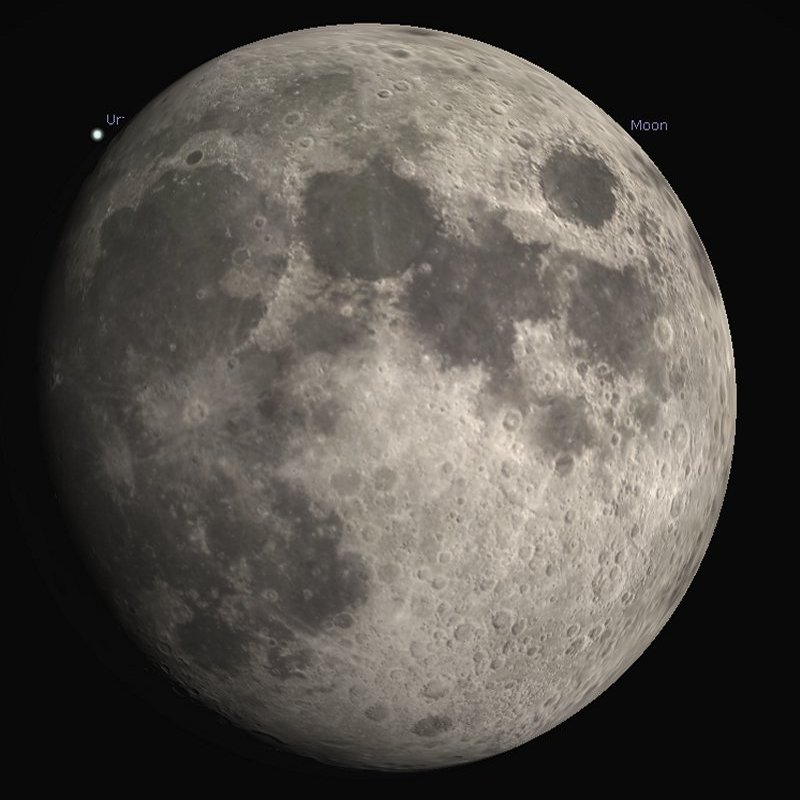 |
| |
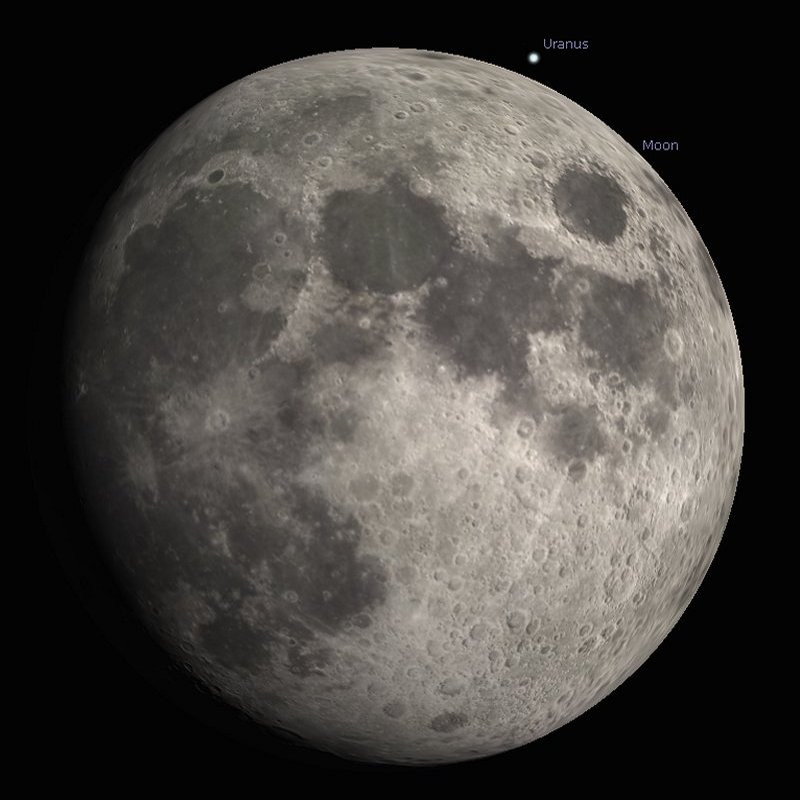 |
| |
|
Of course, Uranus is a small target for your
telescope or binoculars, currently shining at a magnitude of only +5.6 and
the Moon will be almost at its full phase, so creating a lot of light
pollution. |
| |
|
If you are up early on Thursday 8th around
4.50am and look towards the west, you can catch the Full Moon occulting
Mars. The Red Planet will take 37 seconds to disappear behind the north
west limb of the Moon at 4.57am and 37 seconds to reappear from behind the
south east limb a whole hour later. |
| |
|
Because Mars is so bright, shining at a
magnitude of -1.9, the event can even be viewed with the naked eye! |
| |
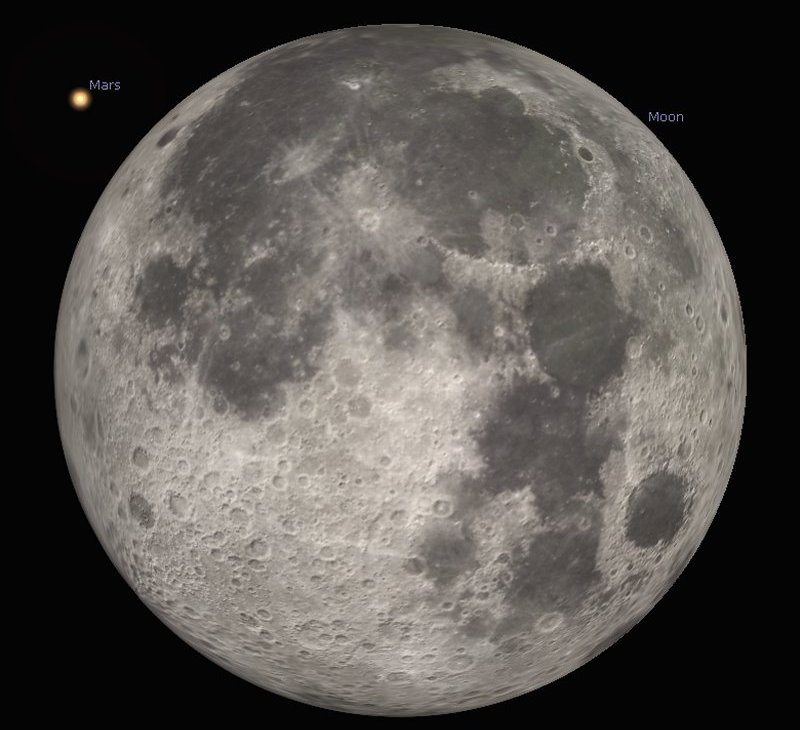 |
| |
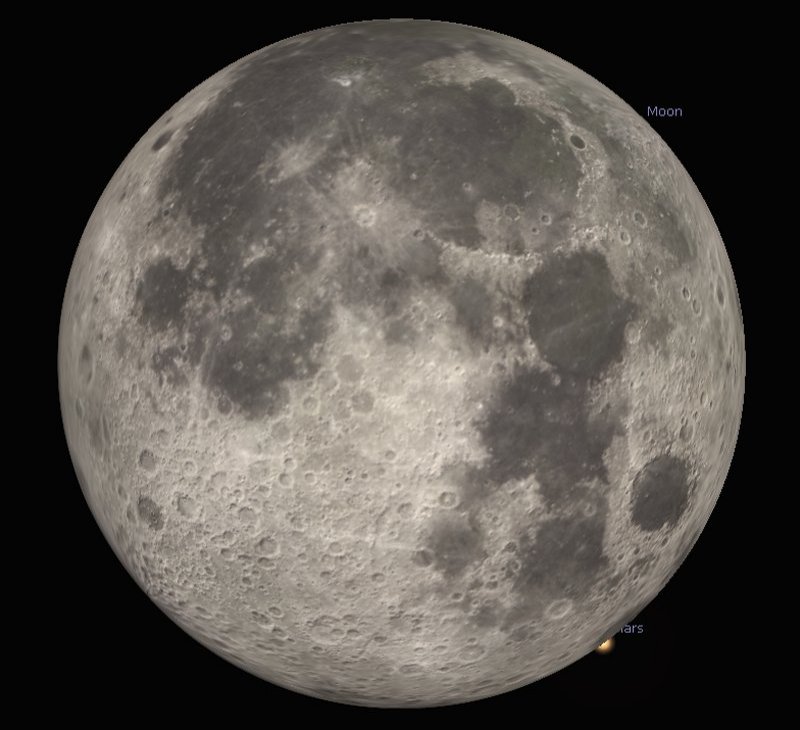 |
| |
|
In a twist of fate, Mars reaches opposition,
when it is at its absolute brightest, while it's behind the Moon at 5.36am
that morning! |
|
Monday 28th
November to Sunday 4th December 2022 |
| |
|
It really is the best time to aim your
telescope towards Mars as the planet is only one week away from opposition,
when it will be at its very brightest. Next week, it will be shining at a
magnitude of around -1.8 and if you are outside around 9pm, the planet will
be located towards the east, a little above the constellation of Orion and
below the Pleiades open cluster of stars. |
| |
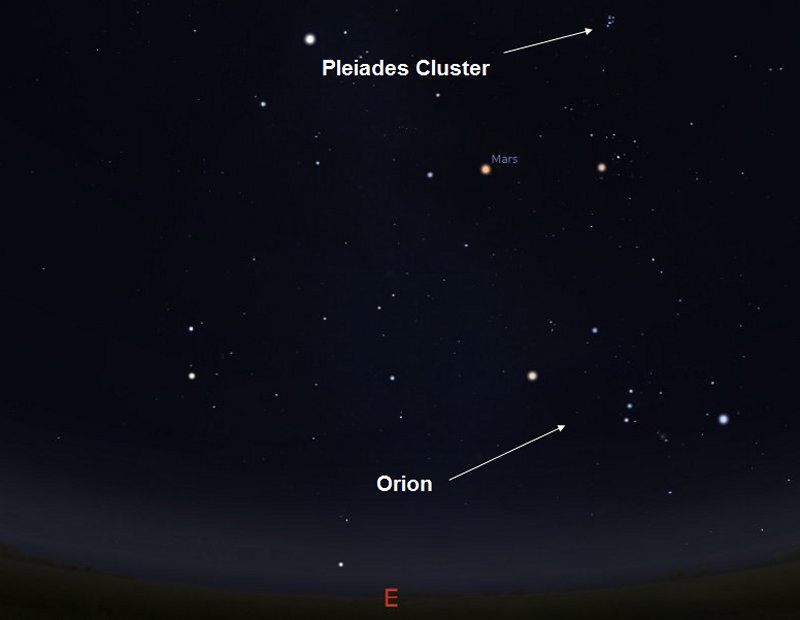 |
| |
|
Also Mars reaches an altitude of 60 degrees
in the sky which provides better viewing as the light reflecting from the
planet's surface is entering our atmosphere at a sharper angle and so
travels through less of it to reach your eyes. When an object is lower in
the sky, the light travels through a thicker layer of atmosphere and this
distorts everything. It's the same reason why stars twinkle - they don't
really, but the faint light coming from them gets scattered as it travels
through our air. |
| |
|
Some stars do vary in brightness though.
Look to the left of the Pleiades and find the constellation of Perseus.
Then identify the star Algol, also known as the "Demon Star". It is
actually an eclipsing binary star system where two stars orbit around each
other. The pair normally has a steady magnitude of +2.2, but every 2.86
days it drops to +3.4 as one star appears to pass in front of the other over
a period of ten hours. |
| |
 |
| |
|
An ancient Egyptian calendar of lucky and
unlucky days, composed 3200 years ago, is the earliest known documentation
of Algol's discovery and they associated it with a demon-like creature. |


































